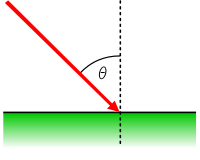cs498gd:physics_collisions
Table of Contents
Physics, Collisions
Basic Physics: Preliminaries
- What kinds of games need physics? What games have physics that you know of?
- Angry Birds, Tower/World of Goo, Crayon Physics, platformers
- Assume fixed discrete simulation (constant time step).
- Approximation (This isn't climate modeling or rocket science or something.)
- “If You Can Get Away With it, Fake it” (From "How to Prototype a Game in Under 7 Days")
- Working with a 2D coordinate system.
- If you need a formula (e.g., that involves forces or mass), look it up.
- Keep it as simple as possible.
- Use the metric system (e.g., m, m/s)
Position and Velocity
- Question: Where is the object at time t?
- Velocity - “The rate of change of position along a straight line with respect to time”
- Speed and velocity are not the same; velocity is a vector quantity (has direction) while speed is a scalar quantity.
- Given variables: object_x, object_y, speed, angle
- Calculation of an object's next x and y coordinates (in your game loop):
- scale_x = cos(angle)
- scale_y = sin(angle)
- velocity_x = (speed * scale_x)
- velocity_y = (speed * scale_y)
- object_x = object_x + velocity_x
- object_y = object_y + velocity_y
Acceleration
- Acceleration - “The rate of change of velocity with respect to time”
- When an object moves along at a certain velocity, an amount of acceleration is continuously added to the velocity.
- Given variables: object_x, object_y, speed, acceleration, angle
- Calculation of an object's next x and y coordinates (in your game loop):
- scale_x = cos(angle)
- scale_y = sin(angle)
- speed = speed + acceleration
- velocity_x = (speed * scale_x)
- velocity_y = (speed * scale_y)
- object_x = object_x + velocity_x
- object_y = object_y + velocity_y
Gravity
- acceleration that only acts downward in the game window
- Earth's gravity constant = 9.81 meters per second squared
- In a game world, the gravity constant will be different, depending on the frame rate.
- Given variables: object_x, object_y
- Calculation of an object's next x and y coordinates (in your game loop; assuming that the object is moving):
- velocity_y = velocity_y - gravity (gravity is a drag on vertical velocity)
- object_y = object_y + velocity_y (if the object has not hit the ground yet)
- object_x = object_x + velocity_x
- Where gravity computation might be useful
- a character jumping in a sidescroller (a “platformer”), games that involve firing projectiles
Collisions
Collision detection
Bounding box method
- Problem: often have irregularly shaped objects (thus wasted space).
- However, empirically, less space will be wasted using the bounding box method over bounding sphere method.
Collision test, two methods:
- 1. if (object.x >= box.min_x && object.x < = box.max_x && object.y >= box.min_y && object.y < = box.max_y) then collision occurred
- Use same approach for mouse choosing in game menus.
- In your
mouseClicked()or equivalent method, check to see if the object was picked via x-y coordinates.
- 2. Use shapes in Graphics or Graphics2D and see if two intersect. Example:
public boolean collidesWith (Entity other)
{
if (other instanceof RectEntity) {
Rectangle him = new Rectangle();
me.setBounds((int) x, (int) y, sprite.getWidth(), sprite.getHeight());
him.setBounds((int) other.x, (int) other.y, other.sprite.getWidth(), other.sprite.getHeight());
return me.intersects(him);
}
else if (other instanceof CircleEntity) {
Ellipse2D him = new Ellipse2D.Double();
me.setBounds((int) x, (int) y, sprite.getWidth(), sprite.getHeight());
him.setFrame((int) other.x, (int) other.y, other.sprite.getWidth(), other.sprite.getHeight());
return him.intersects(me);
}
else if (other instanceof TriangleEntity) {
boolean collided = false;
Point2D p1 = ((TriangleEntity)other).p1;
Point2D p2 = ((TriangleEntity)other).p2;
Point2D p3 = ((TriangleEntity)other).p3;
collided = me.intersectsLine(p1.getX(), p1.getY(), p2.getX(), p2.getY()) ||
me.intersectsLine(p2.getX(), p2.getY(), p3.getX(), p3.getY()) ||
me.intersectsLine(p3.getX(), p3.getY(), p1.getX(), p1.getY());
return collided;
}
else {
System.out.println("Other Entity's shape is ambiguous!");
return false;
}
}
Collision response
- Different objects respond differently to collisions
- Some collisions will resemble that of balls on a billiards table (elastic collision).
- Angle of incidence - The angle between the ball movement vector and the plane of the billiards rail that it strikes when the ball moving in a straight line collides with it.

- Remember, when the ball hits the rail, it will bounce away from the rail at the same angle that it strikes the rail. (assumes no spin on ball)
- In other words, the angle of reflection = angle of incidence
- Calculation (adapted from GameSprite.java):
if ((ballPoint.x + ballSpeed.x) <= plane.x) {
ballSpeed.x = (ballSpeed.x * -1);
}
if ((ballPoint.x + ballSpeed.x) >= (plane.width)) {
ballSpeed.x = (ballSpeed.x * -1);
}
if ((ballPoint.y + ballSpeed.y) <= plane.y) {
ballSpeed.y = (ballSpeed.y * -1);
}
if ((ballPoint.y + ballSpeed.y) >= (plane.height)) {
ballSpeed.y = (ballSpeed.y * -1);
}
Java 2D Gravity and Collision Examples:
- Gravity and collision example: CannonFireTest
- Gravity example: Lander
- Collision example: Pong
- Get all 3 Eclipse projects at https://cssegit.monmouth.edu:2443/jchung/JavaPhysicsCollisionExamples.git
cs498gd/physics_collisions.txt · Last modified: by jchung
